
The Doge of Venice was the highest role of authority within the Republic of Venice. The word Doge derives from the Latin Dux, meaning "leader," originally referring to any military leader, becoming in the Late Roman Empire the title for a leader of an expeditionary force formed by detachments from the frontier army, separate from, but subject to, the governor of a province, authorized to conduct operations beyond provincial boundaries.

The Doge's Palace is a palace built in Venetian Gothic style, and one of the main landmarks of the city of Venice in northern Italy. The palace was the residence of the Doge of Venice, the supreme authority of the former Republic of Venice. It was built in 1340 and extended and modified in the following centuries. It became a museum in 1923 and is one of the 11 museums run by the Fondazione Musei Civici di Venezia.
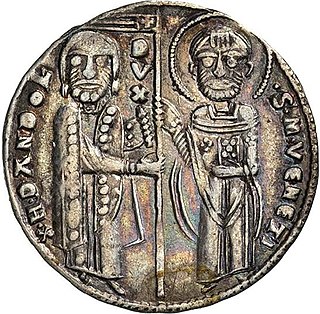
Enrico Dandolo was the doge of Venice from 1192 until his death. He is remembered for his avowed piety, longevity, and shrewdness, and is known for his role in the Fourth Crusade and the Sack of Constantinople. Dandolo died in 1205 in Constantinople and was buried at the Hagia Sophia.

The Lombard League was a medieval alliance formed in 1167, supported by the popes, to counter the attempts by the Hohenstaufen Holy Roman emperors to assert influence over the Kingdom of Italy as a part of the Holy Roman Empire.

The Republic of Genoa was a medieval and early modern maritime republic from the years 1099 to 1797 in Liguria on the northwestern Italian coast. During the Late Middle Ages, it was a major commercial power in both the Mediterranean Sea and the Black Sea. Between the 16th and 17th centuries, it was one of the major financial centers in Europe.
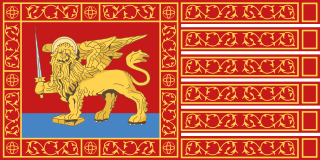
The Republic of Venice or Venetian Republic, traditionally known as La Serenissima, was a sovereign state and maritime republic in parts of the present-day Italian Republic that existed for 1,100 years from 697 until 1797. Centered on the lagoon communities of the prosperous city of Venice, it incorporated numerous overseas possessions in modern Croatia, Slovenia, Montenegro, Greece, Albania and Cyprus. The republic grew into a trading power during the Middle Ages and strengthened this position during the Renaissance. Most citizens spoke the Venetian language, although publishing in Italian became the norm during the Renaissance.

Medieval communes in the European Middle Ages had sworn allegiances of mutual defense among the citizens of a town or city. These took many forms and varied widely in organization and makeup.

A doge was an elected lord and head of state in several Italian city-states, notably Venice and Genoa, during the medieval and Renaissance periods. Such states are referred to as "crowned republics".
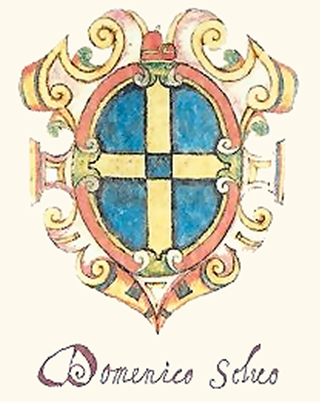
Domenico Selvo was the 31st Doge of Venice, serving from 1071 to 1084. During his reign as Doge, his domestic policies, the alliances that he forged, and the battles that the Venetian military won and lost laid the foundations for much of the subsequent foreign and domestic policy of the Republic of Venice. He avoided confrontations with the Byzantine Empire, the Holy Roman Empire, and the Roman Catholic Church at a time in European history when conflict threatened to upset the balance of power. At the same time, he forged new agreements with the major nations that would set up a long period of prosperity for the Republic of Venice. Through his military alliance with the Byzantine Empire, Emperor Alexios I Komnenos awarded Venice economic favors with the declaration of a golden bull that would allow for the development of the republic's international trade over the next few centuries.

The Signoria of Venice was the supreme body of government of the Republic of Venice. The older Commune of Venice was replaced by the Signoria from 1423 on, being later officially adopted in the Promissione Ducale by Cristoforo Moro. It constituted a center of power which included the doge's power.

The Doge's Palace is a historical building in Genoa, northern Italy.
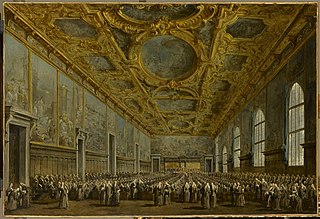
The Great Council or Major Council was a political organ of the Republic of Venice between 1172 and 1797. It was the chief political assembly, responsible for electing many of the other political offices and the senior councils that ran the Republic, passing laws, and exercising judicial oversight. Following the lockout of 1297, its membership was established on hereditary right, exclusive to the patrician families enrolled in the Golden Book of the Venetian nobility.
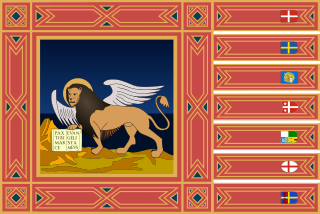
The Statute of the Region of Veneto is the constitution of Veneto, a Region of Italy.
The Council of Forty, also known as the Quarantia, was one of the highest constitutional bodies of the Republic of Venice, with both legal and political functions as the supreme court.
The Avogadori de Comùn, literally "public prosecutors", were an institution of the Republic of Venice. The Avogadori were responsible for taking care of and defend the interests of the Commune Veneciarum, meaning the union of noble families in the Government of Venice, in a manner similar to that of a modern State Attorney.
The Concio, in the Republic of Venice, was the general assembly of freemen from which the Doge was elected. It existed between the years 742 and 1423, although it was mostly ceremonial after the Serrata del Maggior Consiglio passed power into the hands of the aristocratic class.
The Great Council Lockout refers to the constitutional process, started with the 1297 Ordinance, by means of which membership of the Great Council of Venice became hereditary. Since it was the Great Council that had the right to elect the Doge, the 1297 Ordinance marked a relevant change in the constitution of the Republic. This resulted in the exclusion of minor aristocrats and plebeians from participating in the government of the Republic. Although formerly provisional, the Ordinance later became a permanent Act, and since that time it was disregarded only at times of political or financial crisis.

The Minor Council or Ducal Council was one of the main constitutional bodies of the Republic of Venice, and served both as advisors and partners to the Doge of Venice, sharing and limiting his authority.

The Republic of Venice was dissolved and dismembered by the French general Napoleon Bonaparte and the Habsburg Monarchy on 12 May 1797.
The promissione ducale was an oath of office sworn by the incoming Doge of Venice. It contained not only an oath of allegiance to the Republic of Venice, but also spelled out the constitutional limitations to the Doge's power, which he swore to abide by.















